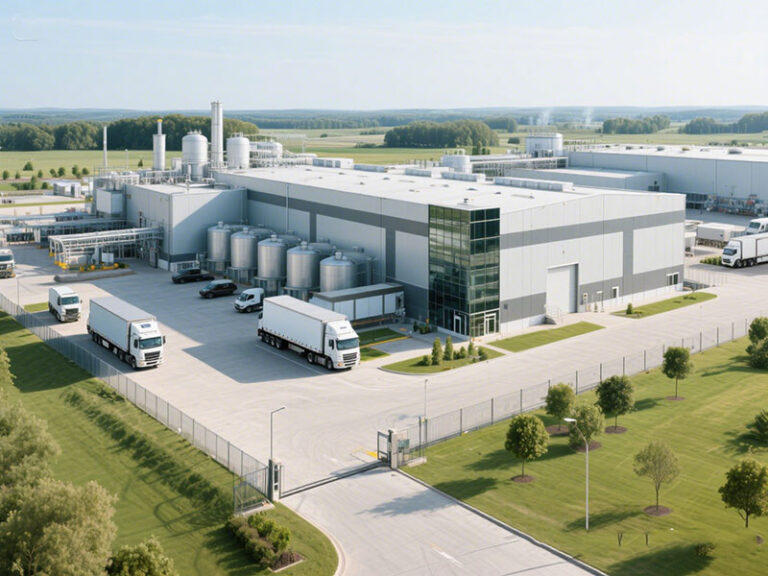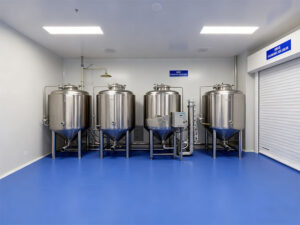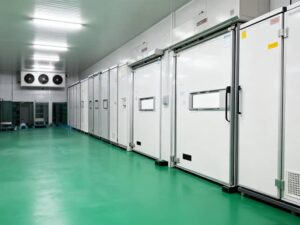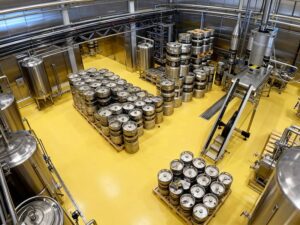I. Introduction
1.1 The importance of flooring selection for food processing plants
In the food processing industry, the selection of flooring is by no means a trivial matter; it has a crucial impact on the overall operation of the plant. Firstly, from the perspective of food hygiene and safety, the flooring is a fundamental component of the food production environment. During the food processing process, it is inevitable that food residues, liquids, etc. will spill on the floor. If the flooring material is unhygienic and difficult to clean, it will become a breeding ground for bacteria and microorganisms. These bacteria and microorganisms may contaminate food, thereby posing potential threats to consumers’ health. For example, in some dairy product processing plants, if the flooring cannot effectively prevent the growth of bacteria, the dairy products may be contaminated, leading to symptoms such as diarrhea and vomiting in consumers after consumption.
Secondly, the safety of the flooring is of great significance to employees. Food processing areas are usually wet, and employees move around frequently during operation. If the anti – slip performance of the flooring is poor, employees are prone to slipping and getting injured. This not only causes physical pain to employees but also affects the normal production order of the enterprise and increases the enterprise’s work – related injury compensation costs. According to statistics, work – related injuries caused by slipping account for a relatively high proportion in the food industry. In addition, the durability of the flooring also affects production efficiency and the service life of equipment. If the flooring is not wear – resistant or impact – resistant, it is prone to wear and damage during long – term production. This requires frequent repair and replacement, which not only increases the enterprise’s costs but also leads to production downtime and affects production efficiency. At the same time, uneven flooring may also damage equipment and shorten its service life.
1.2 Introducing the topic: How to choose the right flooring for a food processing plant
Given the importance of flooring selection for food processing plants, how to choose the right flooring has become a focus of attention for many enterprises. Choosing the right flooring requires comprehensive consideration of multiple factors, including production processes, environmental characteristics, compliance requirements, flooring performance requirements, and costs. Next, this article will introduce in detail how to choose the right flooring for a food processing plant and provide some references and suggestions for enterprises.
II. Understanding the needs of food processing plants
2.1 Production processes and environmental characteristics
Different food processing processes have different requirements for flooring. For example, in high – temperature baking workshops, the flooring needs to have high – temperature resistance, being able to withstand high temperatures without deformation or releasing harmful substances. In some high – temperature baking processes, the temperature may reach several hundred degrees. If the flooring is not heat – resistant, it will deform, crack, etc., which not only affects the service life of the flooring but may also contaminate food. In low – temperature cold storage warehouses, the flooring needs to have low – temperature resistance, being able to maintain flexibility and strength in low – temperature environments and preventing cracking due to temperature changes. In addition, in some food processing processes, various chemicals such as acids, alkalis, and disinfectants are used, so the flooring needs to have chemical corrosion resistance to resist the erosion of these chemicals.
The layout and functional zoning of workshops also affect flooring selection. For example, in processing areas, due to frequent movement of equipment and personnel, the flooring needs to have high wear resistance and impact resistance; in storage areas, the flooring needs to be able to bear the weight of goods and friction during handling; in cleaning areas, the flooring needs to have good waterproof and easy – to – clean properties, being able to quickly drain water and prevent the growth of bacteria.
2.2 Compliance requirements
In the food processing industry, the flooring needs to comply with relevant regulations of the FDA (U.S. Food and Drug Administration), USDA (U.S. Department of Agriculture), etc. These regulations have strict requirements for the material, hygienic performance, safety performance, etc. of the flooring. For example, the FDA requires that flooring materials must be non – toxic and harmless and will not cause pollution to food; the USDA has specific requirements for the anti – slip performance and cleaning performance of the flooring. Enterprises must ensure that the selected flooring meets these regulatory requirements when choosing flooring; otherwise, they may face legal risks.
In addition, some third – party certifications and tests, such as NSF certification, can also be used as references for enterprises when choosing flooring. NSF certification is one of the more authoritative certifications in the food industry. Flooring products with NSF certification have higher guarantees in terms of hygiene and safety. Enterprises can choose flooring with NSF certification to ensure that the flooring meets relevant standards and requirements.
III. Considering the performance requirements of flooring
3.1 Hygiene and safety performance
Hygiene and safety are among the most important performance requirements for flooring in food processing plants. Antibacterial performance is an important indicator to measure the hygienic performance of flooring. Flooring with antibacterial function can effectively inhibit the growth and spread of bacteria and microorganisms, reducing the risk of food contamination. For example, some resin floors treated with antibacterial technology can form an antibacterial protective film on the surface to prevent the attachment and reproduction of bacteria. Anti – slip performance is also crucial. In food processing areas, the floor is often wet with water stains, oil stains, etc. Anti – slip flooring can reduce the risk of employees slipping and ensure their safety. Currently, there are many types of flooring with anti – slip textures available on the market. For example, polyurethane anti – slip flooring, with its special surface texture, can increase friction and improve anti – slip performance.
Easy – to – clean property is also an important manifestation of the hygienic performance of flooring. The flooring needs to be able to quickly and thoroughly remove dirt and bacteria on the surface to maintain good hygienic conditions. Some seamless floors are easier to clean because there are no cracks and gaps for dirt and bacteria to hide. In addition, the surface treatment of the flooring also affects its easy – to – clean property. Flooring with a smooth surface is easier to wipe clean.
3.2 Durability performance
In food processing areas, there are usually a large number of equipment and personnel moving around, so the flooring needs to have good durability. Wear resistance is the key, being able to withstand the movement of equipment and the trampling of personnel without obvious wear. For example, some high – strength epoxy resin floors have excellent wear – resistant performance and can still maintain a good surface condition after long – term use. Impact resistance cannot be ignored either, being able to withstand the impact of heavy objects without cracking. In some meat processing workshops, heavy objects often fall. If the impact resistance of the flooring is poor, it is easy to crack, affecting the service life of the flooring.
Chemical corrosion resistance is also an important aspect of the durability performance of flooring. Various chemicals such as acids, alkalis, and disinfectants are used in the food processing process, and the flooring needs to be able to resist the erosion of these chemicals. Some flooring with chemical corrosion resistance, such as polyurethane flooring and polyurea flooring, can maintain stable performance under the long – term action of chemicals and is not easily damaged.
3.3 Adaptability to special environments
The production environment in the food processing industry is complex and diverse, and the flooring needs to adapt to different special environments. High – temperature resistance is very important in some high – temperature processing links. For example, in high – temperature processing processes such as baking and frying, the flooring needs to be able to withstand high temperatures without deformation or releasing harmful substances. Some high – temperature – resistant ceramic floors can maintain stable performance in high – temperature environments and are ideal choices for high – temperature processing areas. Low – temperature resistance is suitable for cold storage and freezing environments. In cold storage rooms, the flooring needs to be able to maintain good flexibility and strength at low temperatures and prevent cracking due to temperature changes. Some polyurethane floors and methyl methacrylate (MMA) floors with low – temperature resistance can be used normally in low – temperature environments.
Moisture resistance is also essential, especially in some wet environments such as aquatic product processing and vegetable washing. Moisture – resistant flooring can prevent moisture from penetrating into the flooring and avoid mildew and deformation. Some epoxy resin floors and cement – based self – leveling floors with moisture – resistant properties can maintain good performance in wet environments.
IV. Evaluating different types of flooring
4.1 Epoxy flooring for food industry
Epoxy flooring is a common type of flooring for food processing plants. It has advantages such as good wear resistance, strong chemical corrosion resistance, excellent anti – slip performance, and easy cleaning. Epoxy flooring can improve its performance by adding different aggregates and additives. For example, adding quartz sand can improve its wear resistance, and adding anti – slip agents can improve its anti – slip performance. In addition, epoxy flooring can also be designed in different colors and patterns according to needs, making the workshop more beautiful.
However, epoxy flooring also has some disadvantages. High construction requirements are one of its main drawbacks. If the construction is improper, problems such as bubbles and cracks are likely to occur, affecting the quality and service life of the flooring. In addition, epoxy flooring may soften in high – temperature environments and is not suitable for high – temperature processing areas.
4.2 Polyurethane flooring
Polyurethane flooring has advantages such as good flexibility, strong anti – slip performance, easy cleaning, and good low – temperature resistance. The flexibility of polyurethane flooring enables it to adapt to slight deformation of the ground and reduce the occurrence of cracks. Strong anti – slip performance can effectively reduce the risk of employees slipping and ensure their safety. Easy – to – clean property allows the flooring to quickly and thoroughly remove dirt and bacteria and maintain good hygienic conditions. In addition, polyurethane flooring can still maintain good performance in low – temperature environments and is suitable for cold storage and freezing environments.
However, polyurethane flooring also has some deficiencies. High price is one of its main disadvantages. Compared with other types of flooring, the price of polyurethane flooring is relatively high, which will increase the enterprise’s procurement costs. In addition, polyurethane flooring is not suitable for floors with drainage slopes because it is easy to flow in a liquid state, which may lead to poor drainage.
4.3 Ceramic flooring
Ceramic flooring has advantages such as high hardness, good wear resistance, strong antibacterial performance, and beautiful appearance. The high hardness of ceramic flooring enables it to withstand the impact of heavy objects without cracking, and good wear resistance can ensure that it still maintains a good surface state after long – term use. Strong antibacterial performance can effectively inhibit the growth and spread of bacteria and microorganisms and reduce the risk of food contamination. In addition, the beautiful appearance of ceramic flooring can make the workshop more tidy and beautiful.
However, ceramic flooring also has some disadvantages. Relatively poor anti – slip performance is one of its main drawbacks. The surface of ceramic flooring is relatively smooth, and it is easy to slip in wet environments, increasing the safety risk for employees. In addition, the installation of ceramic flooring is difficult, and the repair cost is high once it is damaged.
4.4 Methyl methacrylate (MMA) flooring
Methyl methacrylate (MMA) flooring has advantages such as being able to be constructed in low – temperature environments, fast curing speed, and low odor. In low – temperature environments, other types of flooring may not be able to be constructed normally, while MMA flooring can be constructed in low – temperature environments without being restricted by temperature. Fast curing speed allows the flooring to be put into use in a short time, reducing production downtime. Low odor can reduce the impact on employees and improve the comfort of the working environment.
However, MMA flooring also has some deficiencies. Relatively strong odor during the construction process is one of its main disadvantages. Although MMA flooring has low odor after curing, it will produce a certain odor during the construction process, which may affect the health of employees. In addition, the price of MMA flooring is relatively high, which will also increase the enterprise’s procurement costs.
4.5 Polyurea flooring
Polyurea flooring has advantages such as no odor, fast drying speed, being able to withstand a wide temperature range, and good impact resistance. No odor can ensure the air quality of the working environment and reduce the impact on employees. Fast drying speed allows the flooring to be put into use in a short time, improving production efficiency. Being able to withstand a wide temperature range makes polyurea flooring suitable for various environments, whether it is a high – temperature or low – temperature environment. Good impact resistance can ensure that the flooring does not crack when subjected to the impact of heavy objects and prolongs the service life of the flooring.
However, polyurea flooring also has some disadvantages. Limited thickness is one of its main drawbacks. The thickness of polyurea flooring is usually relatively thin, which may not meet the requirements of some places with high requirements for flooring thickness. In addition, the adhesion between polyurea flooring and concrete may not be good, and some special construction techniques are required to ensure the adhesion effect.
V. Considering the cost of flooring
5.1 Purchase cost
The prices of different types of flooring vary greatly. Generally speaking, the price of epoxy flooring is relatively low, which is suitable for enterprises with strict cost control. The prices of polyurethane flooring, ceramic flooring, etc. are relatively high, but their performance is also better, which is suitable for enterprises with high requirements for flooring performance. In addition, the price of flooring is also affected by factors such as brand, quality, and thickness. Enterprises need to choose the right flooring according to their actual situation and budget when selecting flooring.
5.2 Installation cost
The installation cost is also an important factor that enterprises need to consider. Different types of flooring have different installation difficulties, and the installation costs will also vary. For example, the installation of ceramic flooring requires professional workers and tools, and the installation cost is relatively high; while the installation of epoxy flooring is relatively simple, and the installation cost is low. In addition, the installation cost is also affected by factors such as the construction area and construction location. Enterprises need to consider the impact of the installation cost on the total cost when selecting flooring.
5.3 Maintenance cost
The maintenance cost includes cleaning fees, repair fees, etc. Some flooring that is easy to clean and durable has relatively low maintenance costs; while some flooring that requires special maintenance has higher maintenance costs. For example, some flooring with special coatings needs to be cleaned with specific cleaning agents, which will increase the maintenance cost. In addition, the service life of the flooring also affects the maintenance cost. If the service life of the flooring is short, it needs to be replaced frequently, which will also increase the maintenance cost. Enterprises need to comprehensively consider the impact of the maintenance cost on the total cost when selecting flooring.


VI. Selecting a reliable supplier and installation team
6.1 The reputation and qualifications of the supplier
Selecting a reliable supplier is the key to ensuring the quality of the flooring. When selecting a supplier, enterprises need to check the supplier’s reputation and customer reviews to understand the quality of its products and service level. In addition, enterprises also need to check the supplier’s relevant certification and qualification certificates to ensure that it has the ability to produce and sell qualified flooring. For example, some suppliers with NSF certification have more guaranteed product quality and hygienic performance.
6.2 The experience and technical level of the installation team
The experience and technical level of the installation team also affect the installation quality of the flooring. When selecting an installation team, enterprises need to understand its construction cases and experience and examine whether its technicians are professional and skilled. An experienced and skilled installation team can ensure the installation quality of the flooring and avoid problems such as improper installation. In addition, enterprises can also require the installation team to provide after – sales service commitments to ensure that problems can be solved in a timely manner during the use of the flooring.
VII. Case analysis
7.1 Introduction of a successful case
When selecting flooring, a food processing plant fully considered factors such as production processes, environmental characteristics, compliance requirements, flooring performance requirements, and costs, and finally chose a suitable epoxy flooring. During the installation process, the plant selected an experienced and skilled installation team to ensure the installation quality of the flooring. After the installation was completed, the plant used and observed the flooring for a period of time and found that the performance of the flooring was good. The wear resistance, chemical corrosion resistance, anti – slip performance, etc. of the flooring met the plant’s requirements, and the easy – to – clean property of the flooring was also recognized by employees. By choosing the right flooring, the plant not only improved production efficiency, reduced maintenance costs but also ensured the safety of employees and the hygiene and safety of food.
7.2 Enlightenment from the case
This successful case has important enlightenment for other food enterprises. Firstly, when selecting flooring, enterprises need to fully understand their own needs and comprehensively consider multiple factors to choose the most suitable flooring for themselves. Secondly, enterprises need to select a reliable supplier and installation team to ensure the quality of the flooring and the installation quality. In addition, enterprises also need to regularly maintain and care for the flooring to prolong its service life.
VIII. Conclusion
8.1 Summarizing the key points of flooring selection for food processing plants
Selecting the right flooring for a food processing plant requires comprehensive consideration of multiple factors, including production processes, environmental characteristics, compliance requirements, flooring performance requirements, and costs. When selecting flooring, enterprises need to fully understand their own needs and choose the most suitable flooring for themselves. At the same time, enterprises also need to select a reliable supplier and installation team to ensure the quality of the flooring and the installation quality. In addition, enterprises also need to regularly maintain and care for the flooring to prolong its service life.
8.2 Emphasizing the importance of choosing the right flooring for food enterprises
Choosing the right flooring is crucial for food enterprises. The right flooring can ensure food hygiene and safety, reduce the risk of food contamination, and provide consumers with safe and healthy food. At the same time, the right flooring can also improve the work safety of employees, reduce work – related injuries, and improve production efficiency. In addition, the right flooring can also reduce the costs of enterprises, including purchase costs, installation costs, and maintenance costs. Therefore, enterprises need to take the selection of flooring seriously and choose the most suitable flooring.
8.3 Encouraging customers with engineering projects to choose the right flooring according to actual situations
For customers with engineering projects, choosing the right flooring is one of the keys to the success of the project. This article provides some references and suggestions for selecting flooring for food processing plants, hoping to be helpful to customers. Customers need to comprehensively consider according to actual situations when selecting flooring and choose the most suitable flooring for themselves. At the same time, customers can also consult professional flooring suppliers and installation teams to obtain more information and suggestions.







